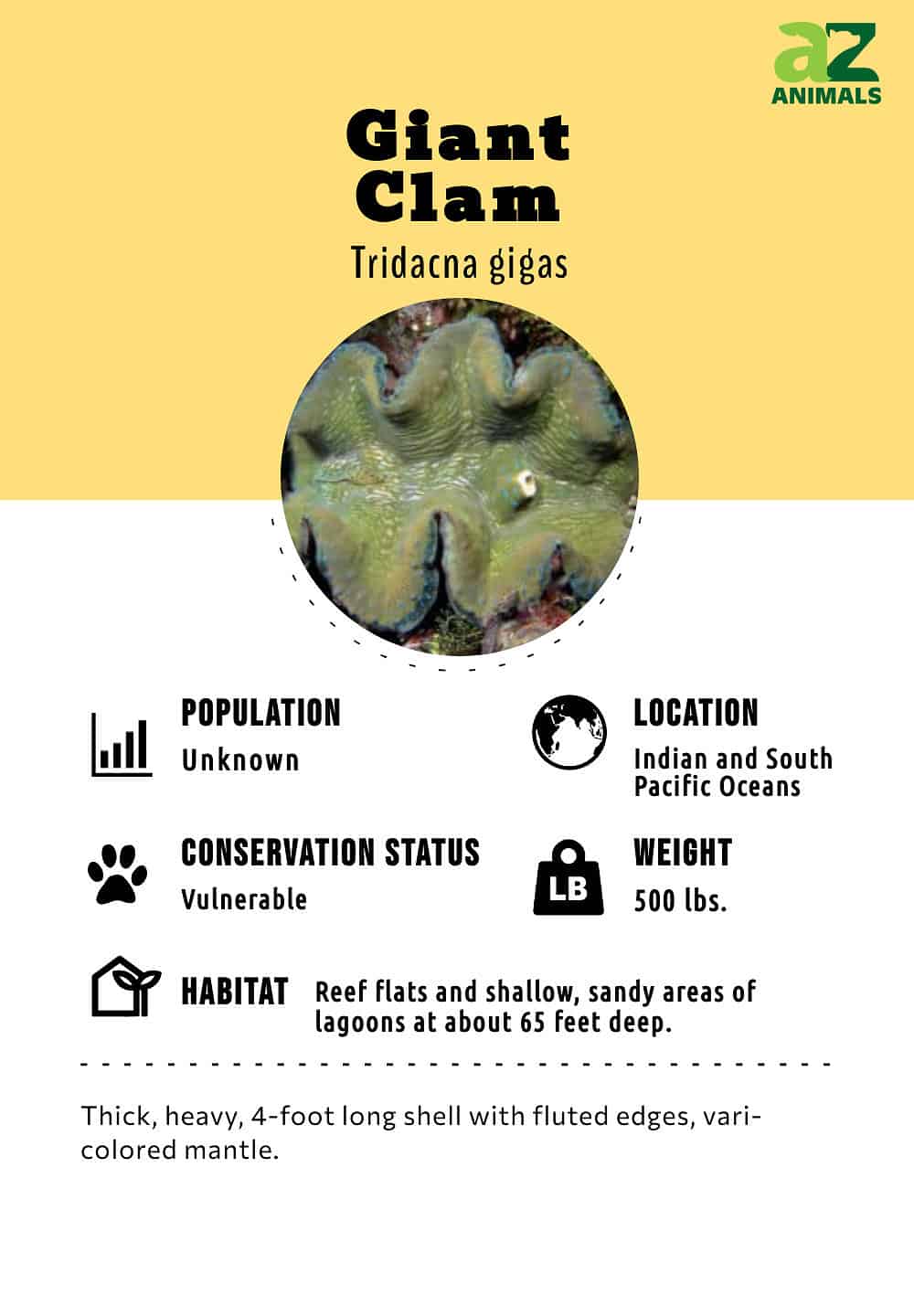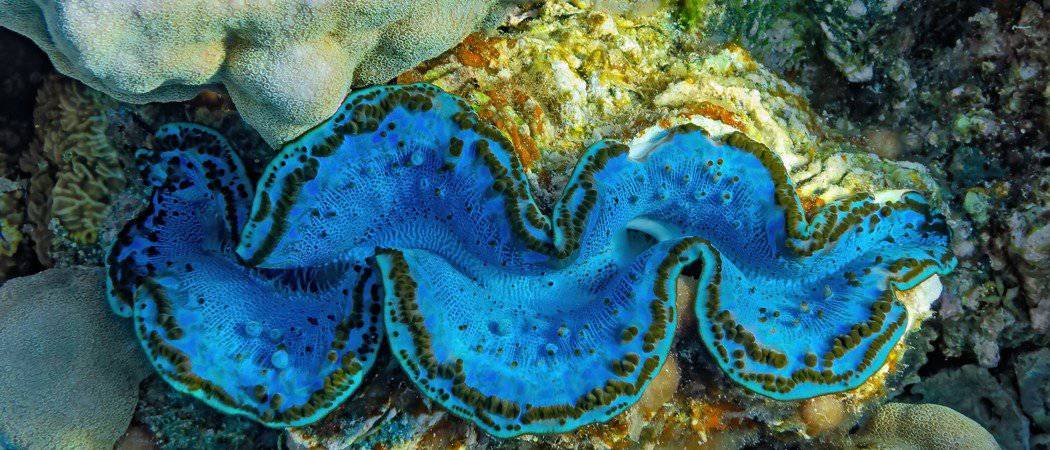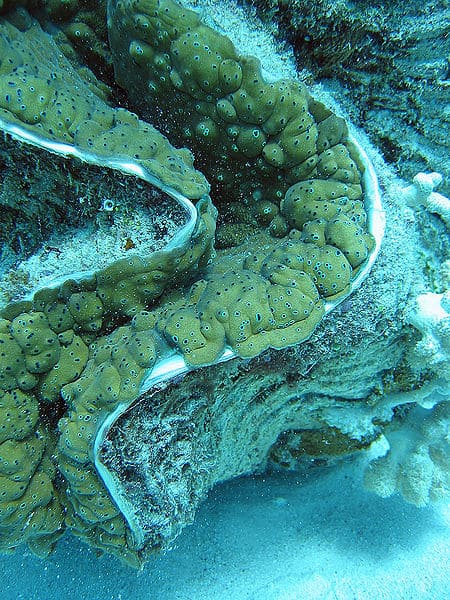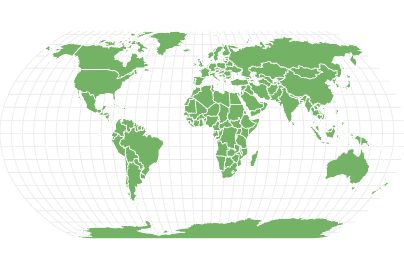Giant Clam
Tridacna gigas
Can reach nearly 4ft in length!
Advertisement
Giant Clam Scientific Classification
- Kingdom
- Animalia
- Phylum
- Mollusca
- Class
- Bivalvia
- Order
- Cardiida
- Family
- Cardiidae
- Genus
- Tridacna
- Scientific Name
- Tridacna gigas
Read our Complete Guide to Classification of Animals.
Giant Clam Conservation Status
Giant Clam Facts
- Favorite Food
- Algae
- Common Name
- Giant Clam
- Number Of Species
- 100
- Location
- Indian and Pacific Oceans
- Slogan
- Can reach nearly 4ft in length!
View all of the Giant Clam images!
The giant clam is the largest, living bivalve mollusk!

Giant clams grow to be about 4 feet in length. They live in the Indian and South Pacific Oceans. The exposed mantle, or soft tissue, of a giant clam features a combination of colors and patterns that can include yellow, green, iridescent blue, and purple. This species of clam is an omnivore eating tiny marine plants as well as animals in the form of zooplankton. The lifespan of this mollusk goes all the way up to 100 years or more!
4 Incredible Facts!
- After attaching itself to a coral reef, this mollusk stays there for the rest of its life.
- The bright colors in this clam’s mantle are caused by the algae in its system.
- There is a legend claiming that these clams eat humans, but this is not true.
- Many clams of this species live on the Great Barrier Reef off the coast of Australia.
Scientific Name

The giant clam is a bivalve mollusk whose scientific name,
Tridacna gigas, means oyster giant.
©Sergius Bleicher/Shutterstock.com
The scientific name of this clam is Tridacna gigas. The word Tridacna comes from the Greek word tridaknos meaning oyster, and the Latin word gigas means giant.
It belongs to the Phylum Mollusk, the Class Bivalve, the Order Cardiida and the Family Cardiidae, subfamily Tridacninae. There are two genera (Hippopus and Tridacna) with twelve known species living in tropical marine waters. Of these, several species are endangered.
One of the other, smaller “giant” clams is the southern giant clam. Its scientific name is Tridacna derasa. Although it has a similar appearance to the Tridacna gigas, the southern giant clam measures just 2 feet in length, so the Tridacna gigas is definitely the owner of the name “giant.”
Bivalve relatives include mussels, scallops, and oysters. The ancestors of bivalves are brachipods. They were the first clam-like species, nearly 252 million years ago. They evolved into clams in what was once the Tethys Sea back when Europe was under water 50 million years ago. Those long-ago, shallow and warm waters are now the Mediterranean Basin. Theory has it that big clams were a critical food source for pre-historic humans before they came out of Africa.
Appearance & Behavior

The soft tissue mantle of the giant clam accounts for only 10% of its body weight; the rest is all shell!
©Andrea Izzotti/Shutterstock.com
These clams have a thick, heavy shell with fluted edges that protects the mantle, or soft tissue, inside it. Its mantle, which accounts for only about 10 percent of its body weight, is colorful, displaying patterns of brown, iridescent blue, green, yellow, and purple. The algae stored in this clam’s body is what makes its mantle so colorful. An adult clam’s mantle has pale spots on it known as windows.
The size of these clams ranges from 4 feet to 4.5 feet in length. They weigh around 500 pounds. Picture 3 bowling pins lined up end to end and you have the length of a 4-foot giant clam. A 500-pound giant clam is equal in weight to half of a horse. The heaviest giant clam on record is 550 pounds!
The sheer size of an adult giant clam, as well as its thick shell, serves as excellent protection against most predators. Furthermore, this clam can close its shell most of the way to protect itself from threats. An adult clam isn’t able to snap its shell closed.
Habitat
These clams live in warm water habitats. Specifically, they are found in the South Pacific and Indian Oceans. They live off the northern coast of Australia, as well as near the Nicobar Islands and Fiji. The Great Barrier Reef near Australia is home to many of these clams. They live in reef flats as well as in shallow, sandy areas of lagoons.
They are usually found at a depth of around 65 feet. In an ocean, a depth of 65 feet is not very deep! Living in shallow areas allows these clams access to filtered sunlight.
Diet

The Giant Clam has a siphoning system, like a swimming pool filter, that brings in the phytoplankton and zooplankton it feeds on.
©Jan Derk – Public Domain
These clams are omnivores. However, since they are attached to a coral reef, they can’t hunt for food. Luckily, the food comes to them! These mollusks have a siphoning system that takes in tiny prey, such as phytoplankton and zooplankton, that floats by. This siphoning system is similar to the filtering system in a backyard swimming pool.
Also, the clam gets nutrients, including sugar and protein, from the billions of particles of algae stored in its tissue. This is what is called a mutually beneficial relationship. The algae enjoy the protection of living in the clam’s body tissue while the clam receives essential nutrients in return. Further, these clams open their shell during the daylight hours to allow sunlight to filter in through the clear spots, or windows, in its mantle; thus the sunlight plays a part in the photosynthesis that feeds the algae.
Predators and Threats
It may seem like the sheer size of this clam would keep all threats away. Nonetheless, this mollusk does have some predators. Reef fish, eels, and starfish eat the meat of the clam. When one of these predators takes a bite, it doesn’t kill the giant clam. However, it does cause injury.
Humans are another threat to this clam. People harvest them for their meat and shells. Specifically, the adductor muscle of a giant clam is considered one of the most delicious parts of this sea creature. They are especially popular in Japan, France, and throughout southeast Asia.
The larvae of these clams are eaten by fish, octopuses, and crabs. These larvae are so small that thousands of them could be eaten by one large fish. This is the main reason why a giant clam releases so many eggs; it increases the chances that some of them will survive to adulthood.
Water pollution is another threat to these clams. Pollution can affect their rate of reproduction.
Reproduction, Babies and Lifespan

This partially closed giant clam, resting on the sea floor, like other hermaphroditic giant clams, can release 500 million eggs at one time!
©Ethan Daniels/Shutterstock.com
Each giant clam has both sperm and eggs; that is, it is hermaphroditic. It reproduces by releasing both sperm and eggs into the open water. One giant clam can release 500 million eggs at one time! Eggs are fertilized by the sperm released by another giant clam. This is called broadcast spawning, and it may be coordinated with the phases of the moon.
The fertilized eggs hatch into larvae. Giant clam larvae circulate in the water looking for plankton and other tiny particles of food until they grow large enough to settle into one place near or on a coral reef.
A developing giant clam goes through many stages. It starts out as an egg and hatches into larvae. After that, it develops into a veliger, a pediveliger, a juvenile, and an adult. Although it takes years for a giant clam to achieve adult weight and size, it has a lifespan of up to 100 years. So, it has plenty of time to grow into a 4-foot, 500-pound grown-up!
Population and Conservation Status
According to the IUCN Red List of Threatened Species, the population of these clams is listed as unspecified. It’s threatened by humans and water pollution. The conservation status of this clam is Vulnerable.
View all 170 animals that start with GGiant Clam FAQs (Frequently Asked Questions)
Are Giant Clams herbivores, carnivores, or omnivores?
Giant Clams are Omnivores, meaning they eat both plants and other animals.
What Kingdom do Giant Clams belong to?
Giant Clams belong to the Kingdom Animalia.
What class do Giant Clams belong to?
Giant Clams belong to the class Bivalvia.
What phylum to Giant Clams belong to?
Giant Clams belong to the phylum Mollusca.
What family do Giant Clams belong to?
Giant Clams belong to the family Tridacnidae.
What type of covering do Giant Clams have?
Giant Clams are covered in Shells.
What genus do Giant Clams belong to?
Giant Clams belong to the genus Tridacna.
Where do Giant Clams live?
Giant Clams live in the Indian and Pacific Oceans.
In what type of habitat do Giant Clams live?
Giant Clams live on saltwater sea floors.
What do giant clams eat?
These sea creatures eat phytoplankton and zooplankton. These are tiny plants and animals that a giant clam siphons into its system and consumes. In addition, giant clams get essential nutrients including sugar and protein from algae that live in their body tissue.
How big is a giant clam?
A giant clam can grow as long as 4.5 feet and weigh as much as 550 pounds.
What does a giant clam look like?
A giant clam has a thick, heavy shell with fluted, or curved edges. The soft tissue, or mantle, inside its shell, displays a pattern and mixture of colors such as yellow, green, iridescent blue, and purple. A giant clam’s mantle can be compared to the fingerprints of a person. No two mantles are exactly alike!
A giant clam’s mantle has clear spots called windows. The sunlight travels through these windows to access the algae living inside the clam’s tissue. The sunlight is necessary for the algae to photosynthesize.
This clam also has two siphons located in its mantle. One siphon takes in water along with phytoplankton and zooplankton. The other siphon releases water.
Are giant clams dangerous?
No. There is a legend that has been around for centuries stating that giant clams are able to grab divers and swallow them! This is why they are sometimes called maneaters. However, this is just a tall tale made popular by movies and fantasy novels.
Do giant clams have pearls?
Yes, a giant clam can have a pearl inside it. However, finding a pearl in a giant clam is a rare occurrence.
Thank you for reading! Have some feedback for us? Contact the AZ Animals editorial team.
Sources
- Wikipedia, Available here: https://en.wikipedia.org/wiki/Giant_clam
- NOAA Fisheries, Available here: https://www.fisheries.noaa.gov/species/giant-clam-tridacna-spp
- Seattle Acquarium, Available here: https://www.seattleaquarium.org/animals/giant-clams

















